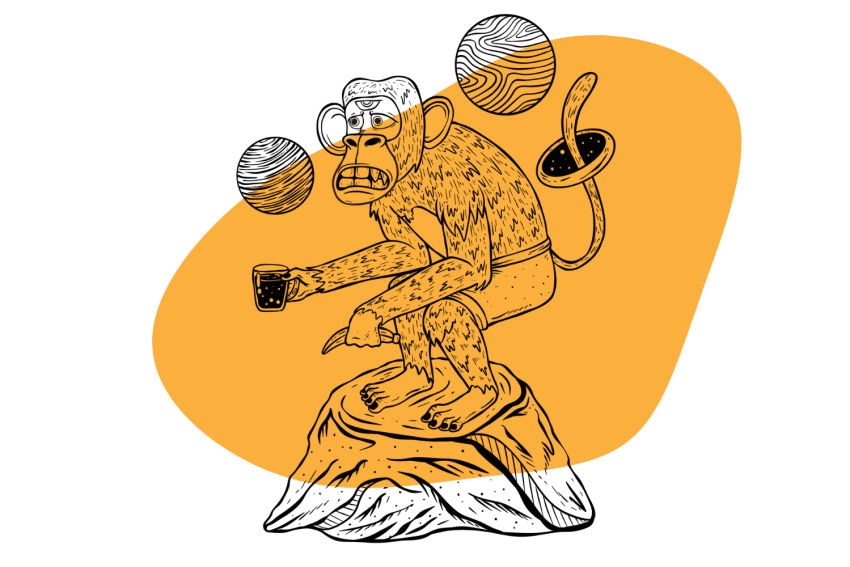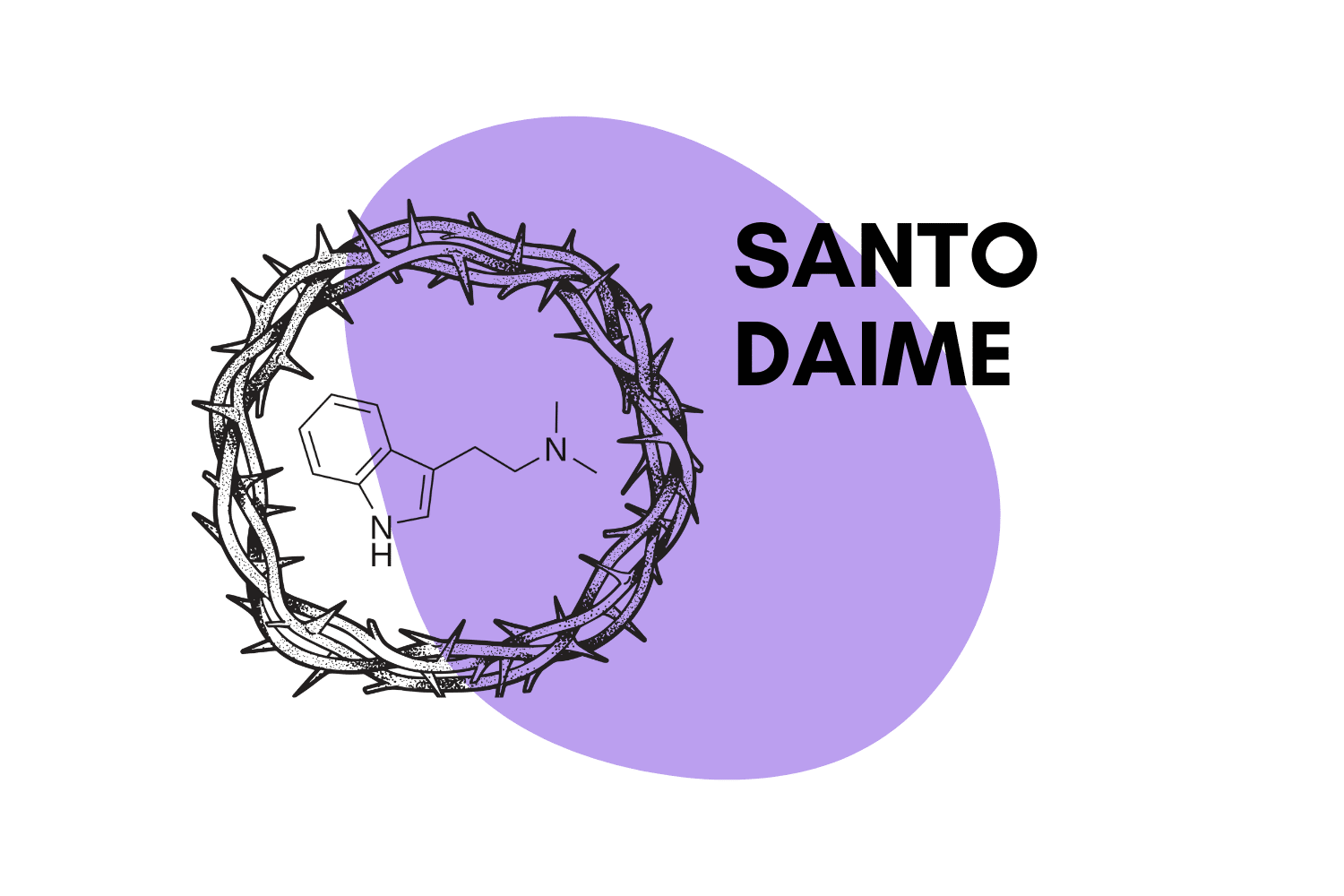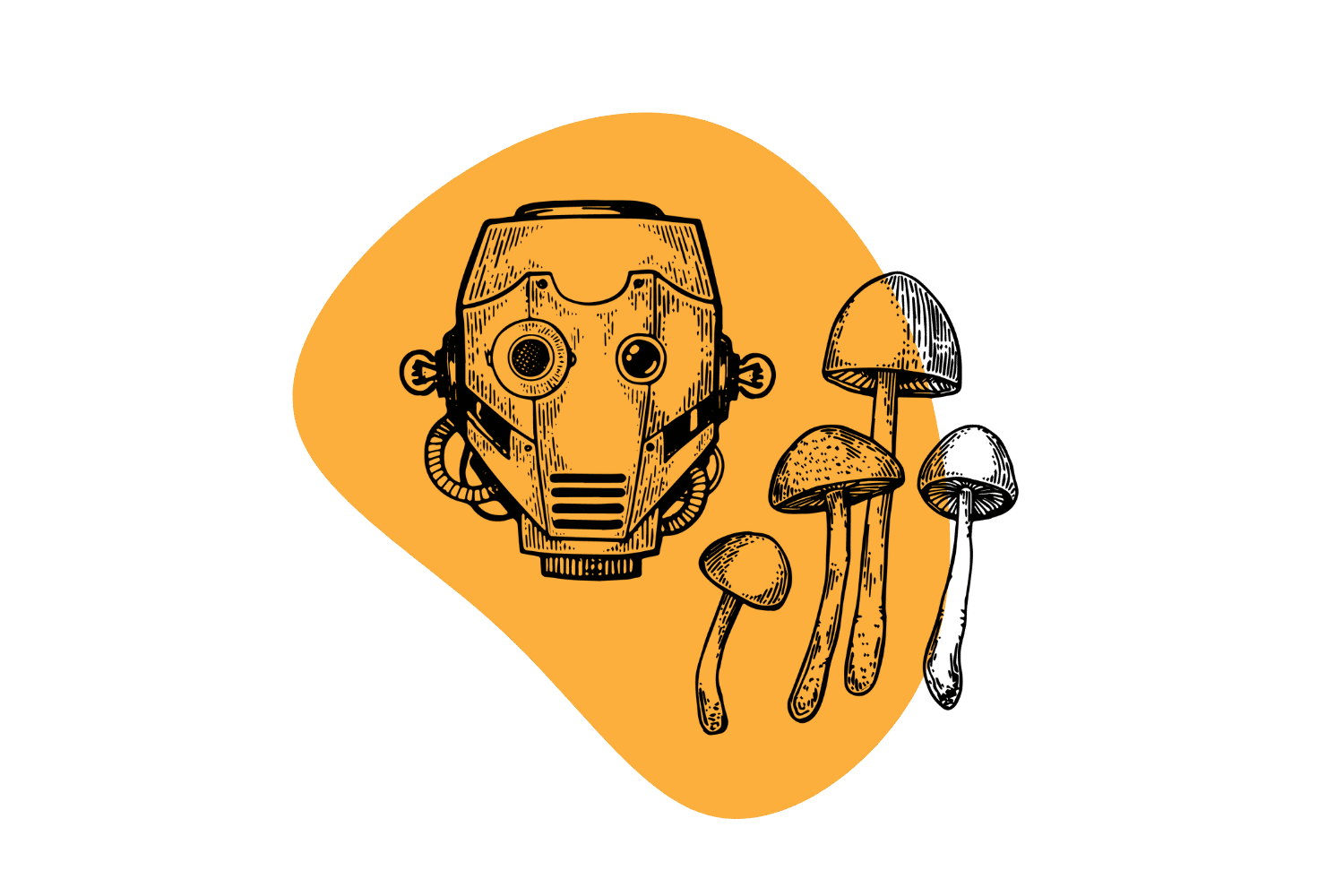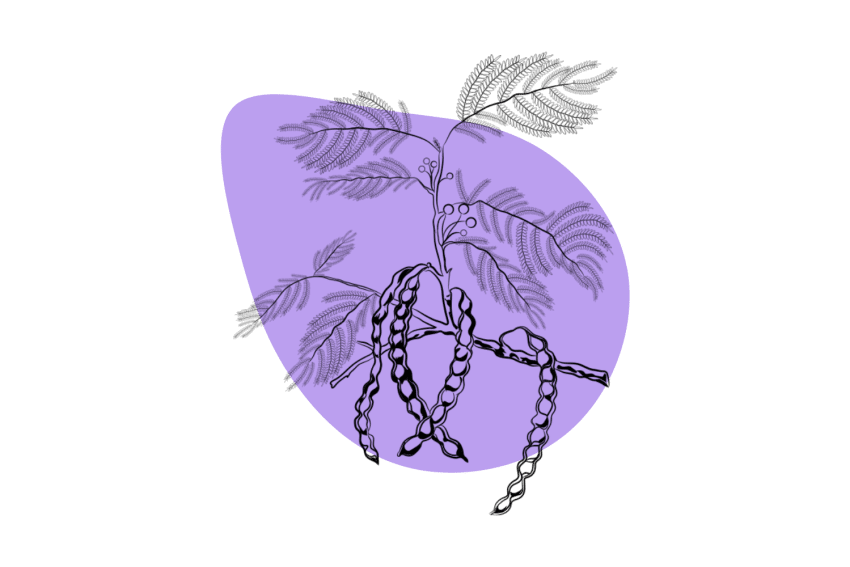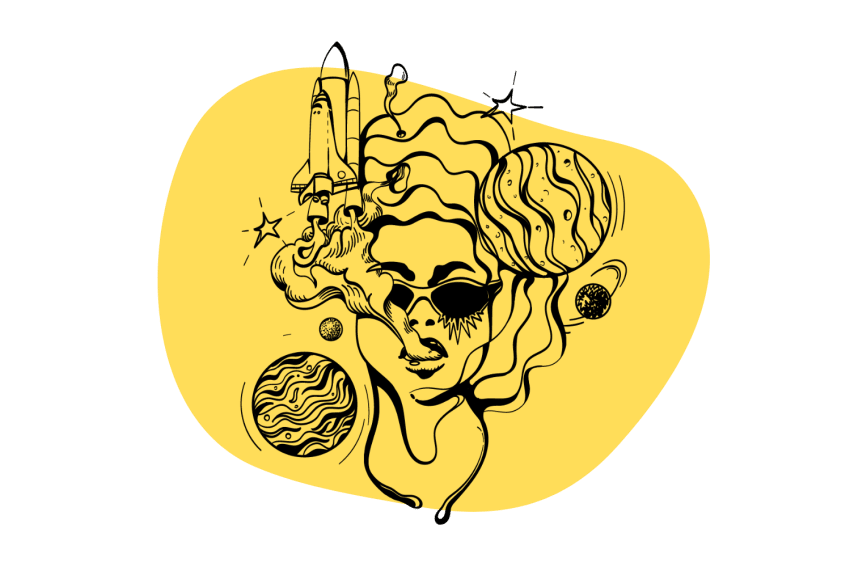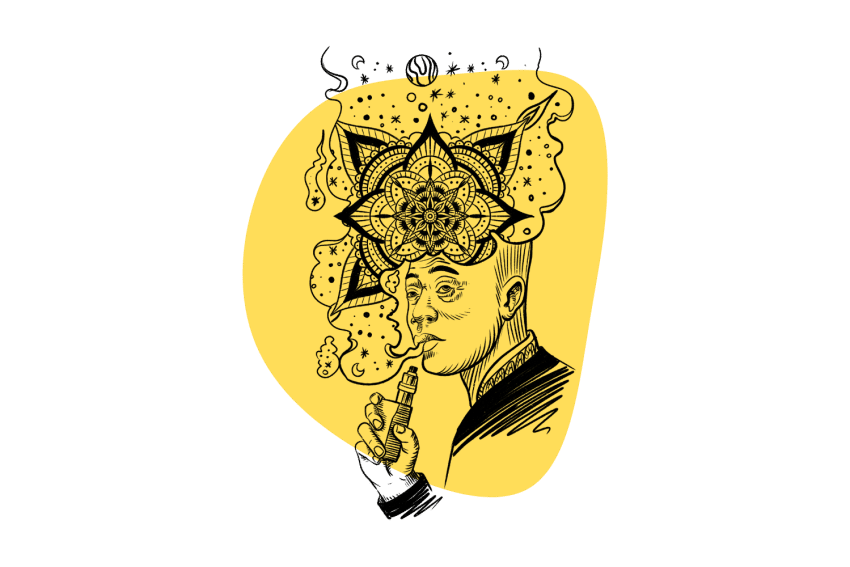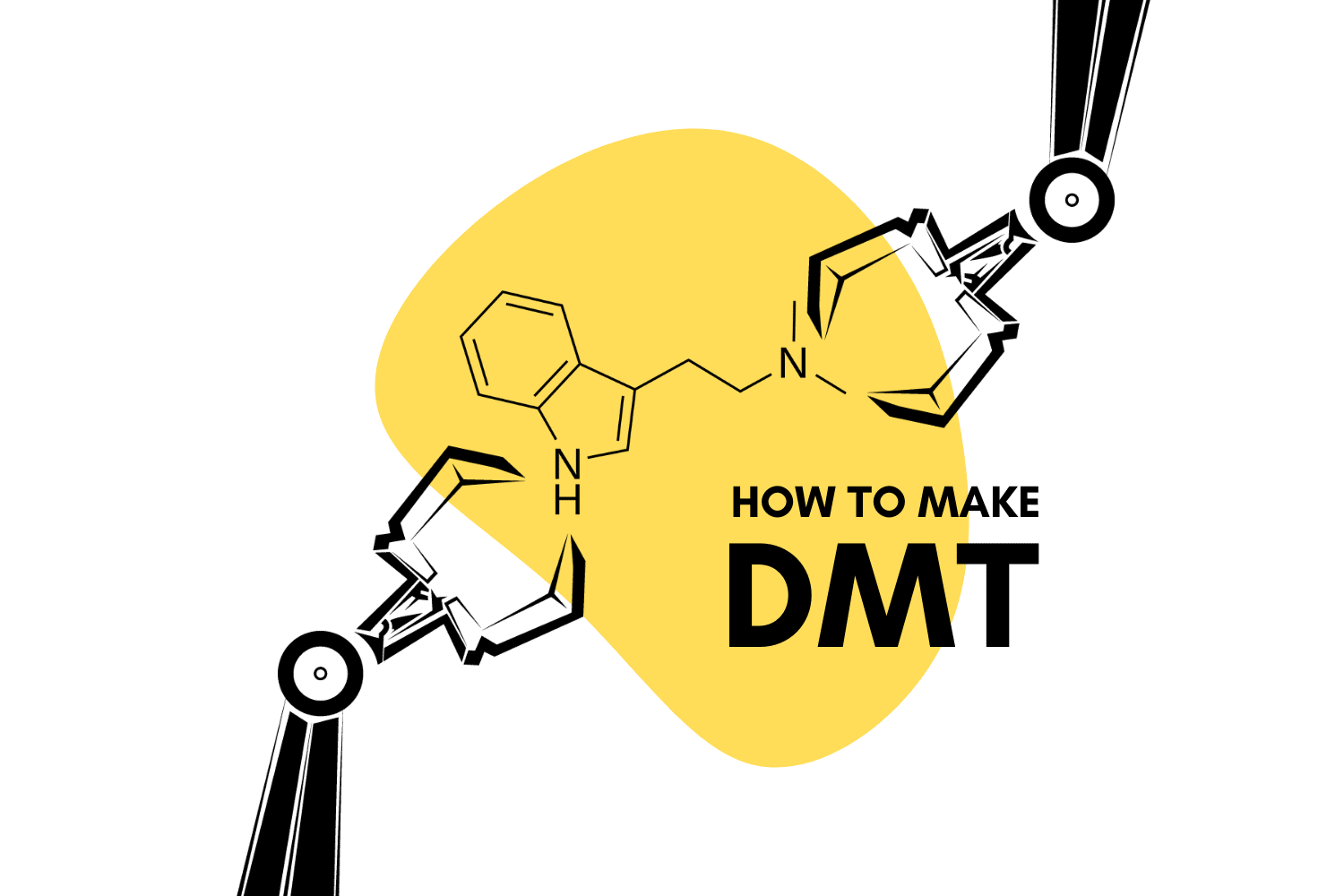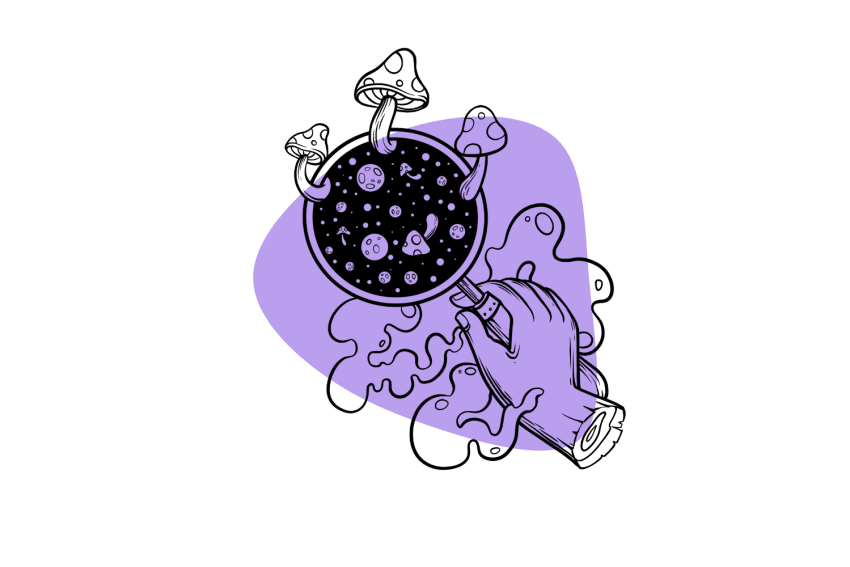Changa: Smokeable Ayahuasca
Changa is a combination of DMT or DMT-containing herbs with a smokable MAO inhibitor.
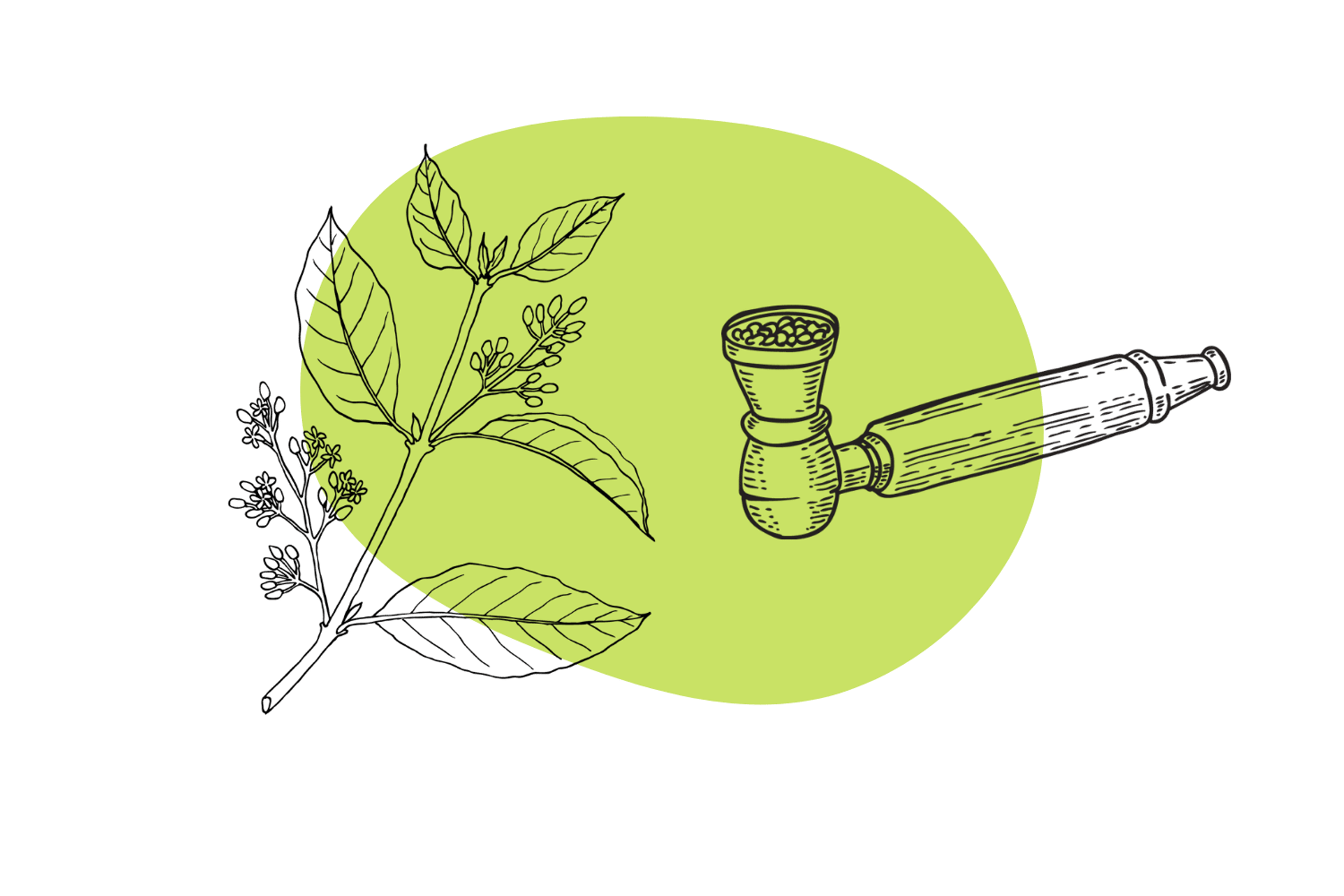
There are many different herbs and additives that can be used to make changa, but the conventional formula uses ayahuasca vine as the core ingredient. Freebase DMT (N,N-dimethyltryptamine) is then dissolved and combined with the ayahuasca vine. Other herbs are added to provide additional psychoactive effects, reduce the harshness of the smoke, or improve the flavor.
While changa was only officially “invented” in the early 2000s, the concept of smoking DMT-containing herbs has been around for a long time.
Even the late Terence McKenna himself reported smoking ayahuasca vine at the peak of a mushroom trip in his 1993 Book — True Hallucinations.
In this article, we’ll cover everything you need to know about changa. We’ll go over the ingredients, safety, dosing, legality, and much more.
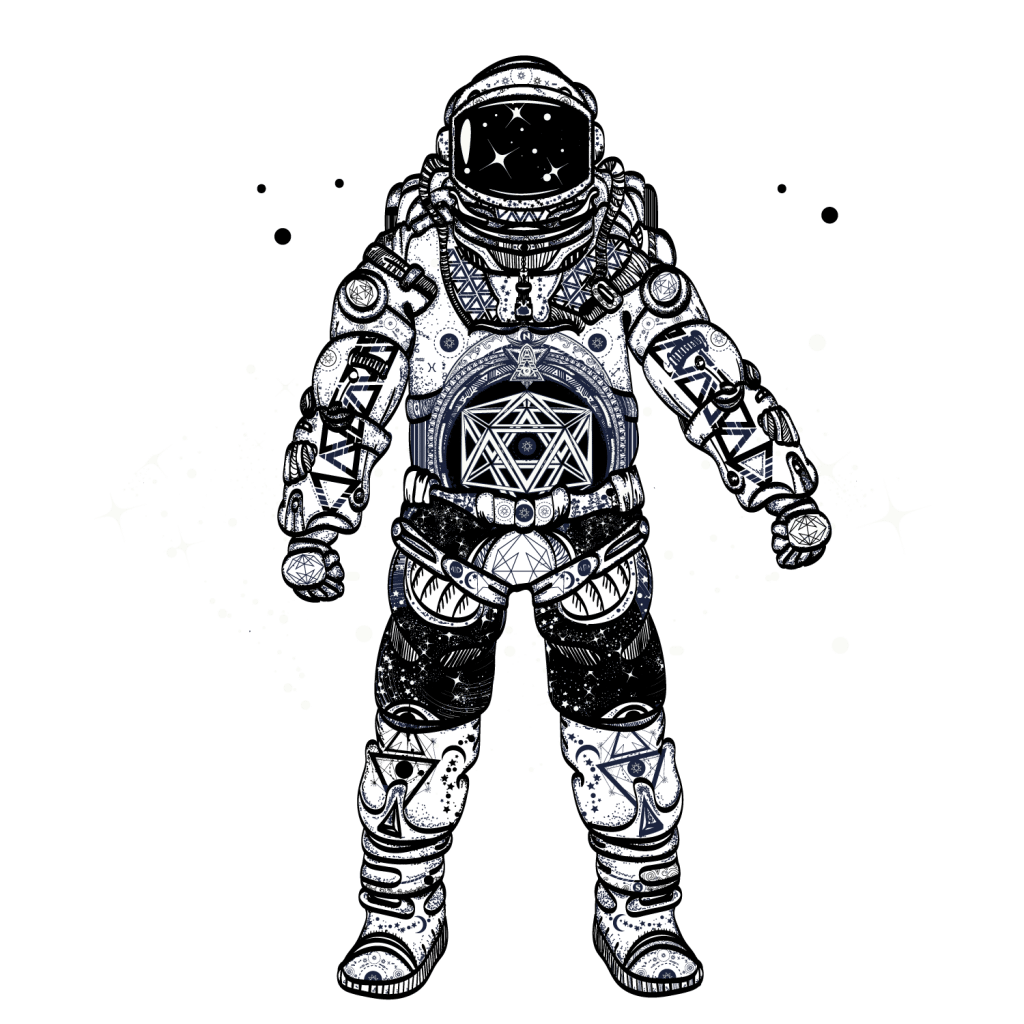
What is Changa?
Changa is a smokable form of ayahuasca. It consists of a blend of herbs, including dried ayahuasca vine (or another MAO inhibitor) and DMT. It’s used as an alternative to ayahuasca or smokeable DMT.
Changa is more gentle than 5-MeO-DMT and not nearly as long-lasting as ayahuasca. It gives users the ability to ease into the DMT realm more slowly. It takes a few tokes to get into the deeper levels, so users aren’t forced into psychedelia so aggressively.
With that said, changa is a formidable psychedelic that demands respect. Many people who try this smokable blend get a lot more than they’ve bargained for.
The basic principle is that the MAO (monoamine oxidase) inhibitor prevents the DMT from being broken down too quickly — resulting in a stronger and longer-lasting DMT experience.
There’s an ongoing debate about what constitutes “true” changa. The original changa creator — an Australian by the name of Julian Palmer — used ayahuasca as a central ingredient in the formula. Today, you can also find changa that uses a herb called Syrian rue, or passionflower, as an alternative to ayahuasca vine.
The source of DMT isn’t specific either. Some use synthetic DMT; others prefer naturally extracted forms or plants that contain DMT like the acacia tree, chacruna, or mimosa.
Other plants are often added to improve the flavor, reduce the harshness of the smoke, or add additional psychoactive effects to the blend.
A similar mixture involving a pharmaceutical MAO inhibitor and synthetic DMT uses the same base principles. This mixture is referred to as pharmahuasca.
Related: How to smoke DMT.
Changa Specs & Technical Details:
| Active Ingredients | Harmala Alkaloids & N,N-DMT |
| Level of Risk | Moderate |
| Street Names | Changa, Xanga, Smokable Ayahuasca |
| Most Common Side Effects | Nausea & Vomiting |
| Duration of Effects | 10 – 45 minutes |
| Legality | Legal in most parts of the world |
Trip Sitter Safe Changa Guidelines
- 📚 Learn the four pillars of responsible psychedelic use — set, setting, sitter, & substance
- 🍄 Know your dose — start very low, and increase the dose over time
- 🐍 Buy from reputable sources only — only order changa from sources you trust
- ⏳ Know the timeline — the effects of Changa are going to last between 10 and 45 minutes
- 🐺 Have a trip sitter nearby — someone you trust who remains sober throughout the experience
- 💊 Don’t mix — it isn’t safe to mix Changa with other drugs, medications, or alcohol
- 🙅♀️ Know when to avoid Changa — don’t take Changa if you have underlying heart, neurological, or psychiatric disorders
How Does Changa Work?
The active ingredient in changa is N,N,DMT — the same active ingredient in ayahuasca and yopo.
DMT is a powerful psychedelic capable of producing profoundly psychedelic states of consciousness. When we take DMT orally, an enzyme called monoamine oxidase (MAO) breaks it down almost immediately.
By blocking MAO with other herbs — such as the ayahuasca vine or Syrian rue — we can prevent DMT from breaking down for a while, which allows it to exert its psychedelic effects.
The MAO inhibitor is critical for oral preparations of DMT (like ayahuasca) to work, but it isn’t as important when smoking DMT.
Smoking or vaping DMT will still produce powerful psychoactive effects before MAO has a chance to break it down. This is how the bufo toad venom (5-MeO-DMT) works.
With that said, adding MAO inhibitors to DMT in smoking blends makes it significantly stronger and longer-lasting.
A changa preparation with about 40% DMT and an MAO inhibitory herb is considerably more potent than 100% free-based DMT at the same dose.
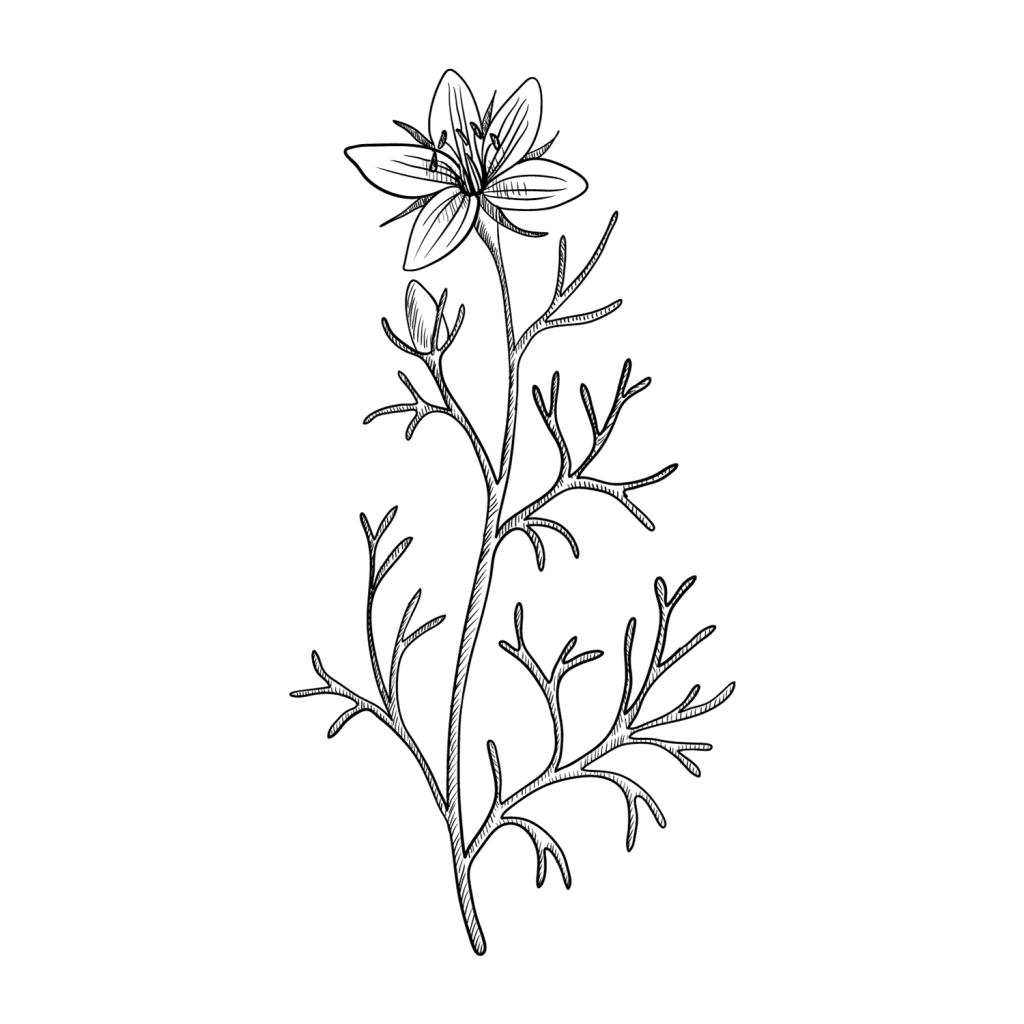
What’s The Dose of Changa?
It’s virtually impossible to suggest a specific dose of changa because of how much variability there is in changa products. The dose wholly depends on what herbs or other ingredients are added to the blend.
However, the general dose of DMT in changa is somewhere between 30 and 200 mg of DMT — so you’ll need to know the rough concentration of DMT in the changa you’re using before you start. This isn’t always easy to find out, and most of the time, you’ll have to find the dose of changa based on how it feels, rather than relying on a specific weight of dried changa leaf.
The best way to use changa is to start with a very small dose. Take one puff and wait a few minutes to see how it affects you. From there, you can take gradually longer pulls or hold the puff for more time before letting it out. The more you smoke, the more psychedelic it becomes.
By applying patience, you can dial in the intensity of effects without going overboard. Smoke a bit, wait, smoke a bit more. Repeat.
Some changa hits like a freight train after just one or two pulls; others are much milder and may require several sessions to get to the DMT dimension. You honestly never know until you try it — and every batch is different.
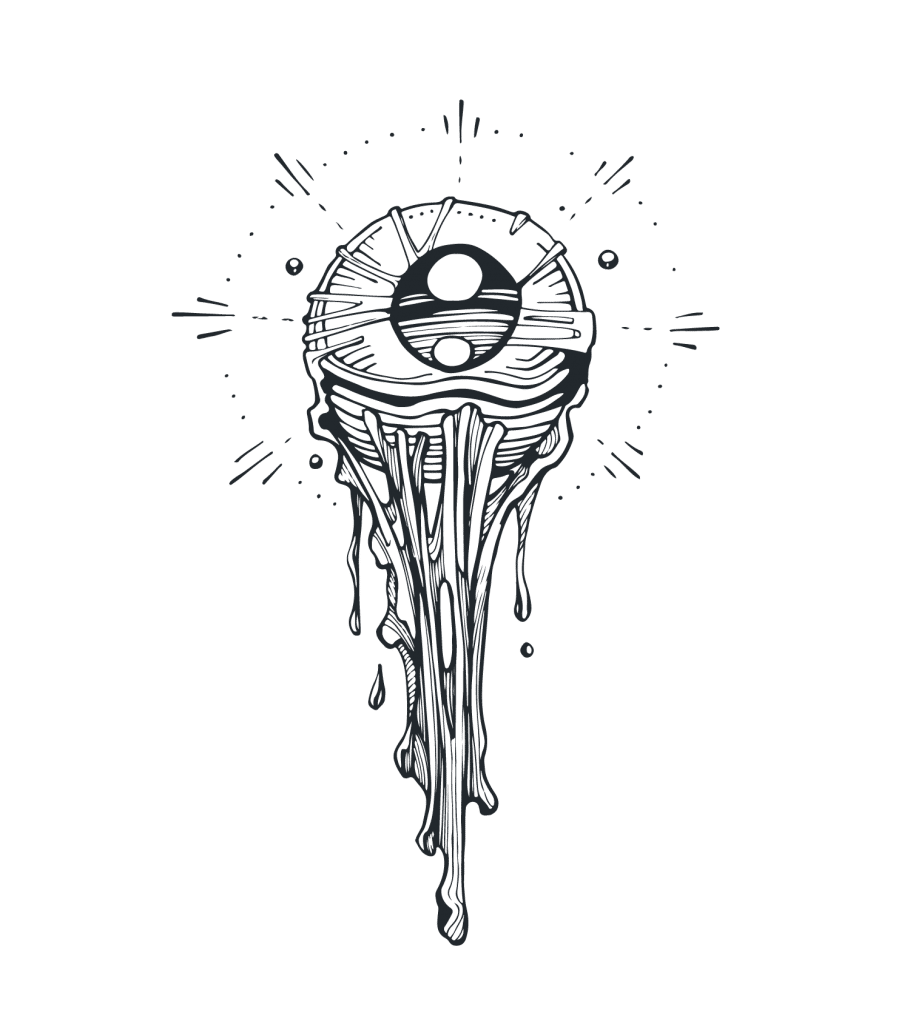
What Does Changa Feel Like?
Changa feels very much like ayahuasca or 5-MeO-DMT. It’s generally much milder than these other forms of DMT, but not always. Some changa trip reports depict extremely profound and deeply psychedelic experiences. Because of how diverse the potential recipes of changa are, the experience can change dramatically.
If you’re adding herbs like calea or mugwort, the experience is going to be much more lucid than if you added something like mullein or peppermint instead.
There are a few different tiers when it comes to the changa experience:
Tier 1: Expanded Awareness State
This state is most similar to LSD (lysergic acid diethylamide) or magic mushrooms. You remain in the “real world” and remain entirely present in your body. However, you feel a stronger sense of connection with others as well as the world around you.
Your visual sphere becomes altered. You see geometric fractal patterns all around you. Objects appear to be moving and merging together, and you may even hear sounds or see colors you’ve never experienced before.
Tier 2: Projection State
The projection state goes one step further than the expanded awareness state. You’ll likely remain aware of your own existence, but you’ve traveled somewhere outside of your body. Usually, this will feel as though you’re still in the same room, but you’re looking at yourself from another perspective.
Visual and auditory hallucinations will be profound. You may experience a sense of oneness or a sense of impending doom. Both are signs of ego-dissolution and can be profoundly enlightening experiences.
It’s common for people to lose some or all control of their bodies during this state. You may laugh uncontrollably, find yourself staring off into space, or lay into the ground in a heap for a few moments.
Tier 3: Alien Realm
This is the third and final tier of the changa (or DMT in general) experience.
At this stage, you’ve lost touch with reality entirely. You may or may not know who or what you are and have traveled to a different place altogether. Often the environment you find yourself in is completely unfamiliar. You may be in an alien world, in a jungle, or in a room you’ve never seen before. The experience is exceptionally vivid and surreal. Many people report “making contact” with aliens — a phenomenon that’s eerily common with DMT trips in general.
Related: What are DMT machine elves?
Time no longer has any meaning. The whole experience itself only lasts about 10 minutes or so before coming back to a more centered consciousness state, but it can feel like you’ve lived several lifetimes while undergoing the experience.
There’s a lot of philosophical debate about how “real” these experiences are. Ultimately, while it’s happening, what you’re experiencing is entirely real. You can see, feel, touch, and interact with the experience the same way you would interface with “normal reality.”
Does Changa Cause a Hangover?
It’s uncommon for people to experience a hangover after using changa, but it isn’t impossible. It really comes down to what ingredients were included in the changa they were using.
Some additives, like chemical additives or herbs like datura or Brugmansia, can cause lasting side effects. They can cause headaches, fatigue, nausea, depression, or lasting hallucinations for several days following the trip.
True changa rarely has lasting negative effects.
In fact, most people report an afterglow — which is a feeling of positivity, spiritual awakening, and constructive introspection for several days following the experience.
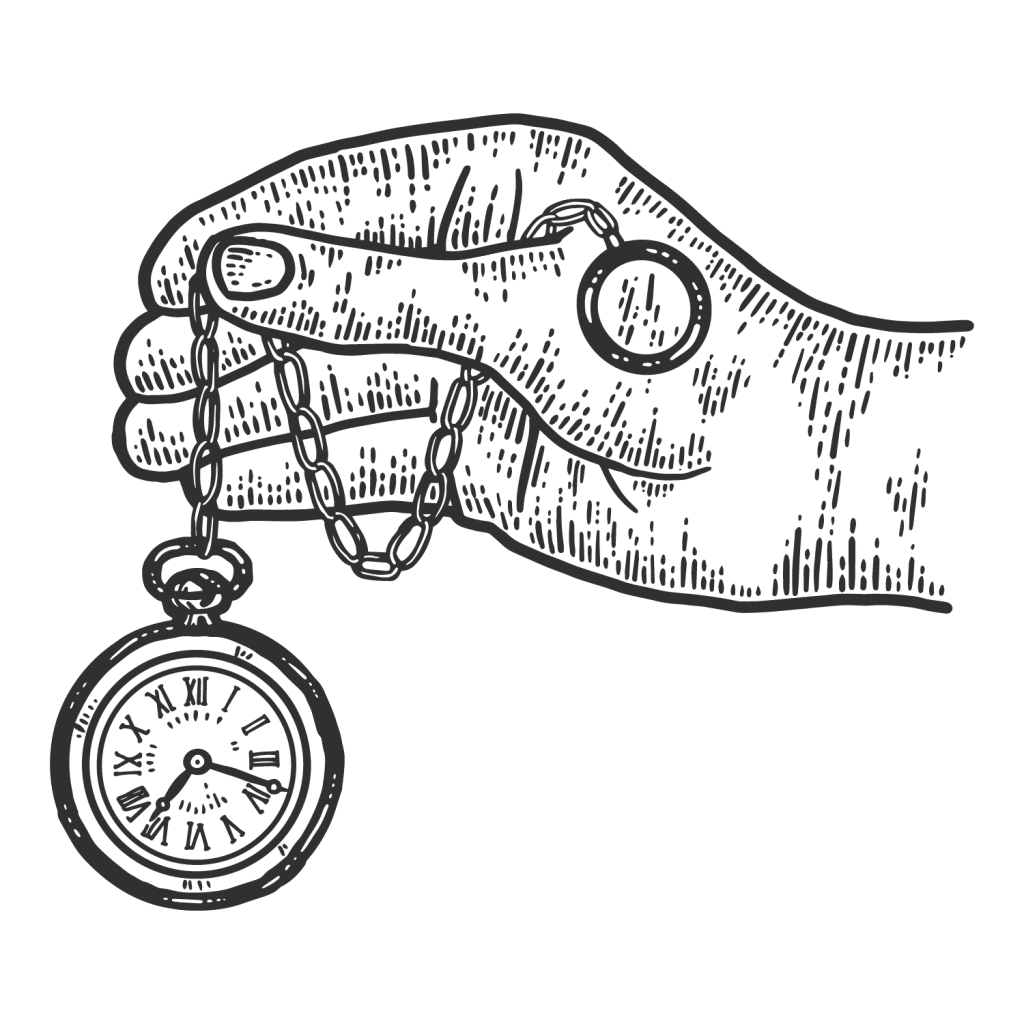
How Long Does Changa Last?
Changa has a very short duration of effects — usually within about 10 to 30 minutes, and in rare cases up to 45 minutes.
The stronger the MAO inhibitor you’re using, the longer the effects remain. Even with the strongest MAo inhibitors, the whole experience rarely lasts more than 45 minutes.
Some users will continue to smoke changa several times, taking breaks between hits for at least 10 minutes. It can take a few hits to reach peak effects, and if the herb mixture is continually smoked, the experience can last as almost as long as you’d like.
Related: How long does DMT last?
How to Use Changa
Changa is used just like any other smokable herb or herb blend. You can pack it in a pipe or bong or roll it up into a changa joint.
Unlike 5-MeO-DMT or salvia extract, changa usually doesn’t hit so hard right from the beginning. You’ll feel its effects, but they’re much milder at first. Most people report having to take several deep pulls before they get anywhere close to the potency of other forms of DMT.
Most people view this as a benefit of changa over other forms of DMT. It allows you to control the celebrity and intensity of the experience by smoking small, deliberate doses of the herb until you get to the level you want.
Compare this to other forms of DMT, like 5-MeO-DMT of bufo toad venom, which can take you from 0 to 100 in a matter of seconds. This degree of celerity can be extremely uncomfortable for those who aren’t ready. It’s like the old adage of Carl Jung — beware of unearned wisdom. Taking a strong psychedelic is like jumping into the deep end of the pool. If you don’t already know how to swim, it can be overwhelming for you — even dangerous.
Changa allows you to reach the deep end of the pool more slowly by swimming to it from the shallow end of the pool.
If you’re going for maximum efficiency, you should smoke changa slowly and deliberately — meaning you shouldn’t rush it or smoke it too fast. Take slow, deliberate hits and hold it as long as you can.
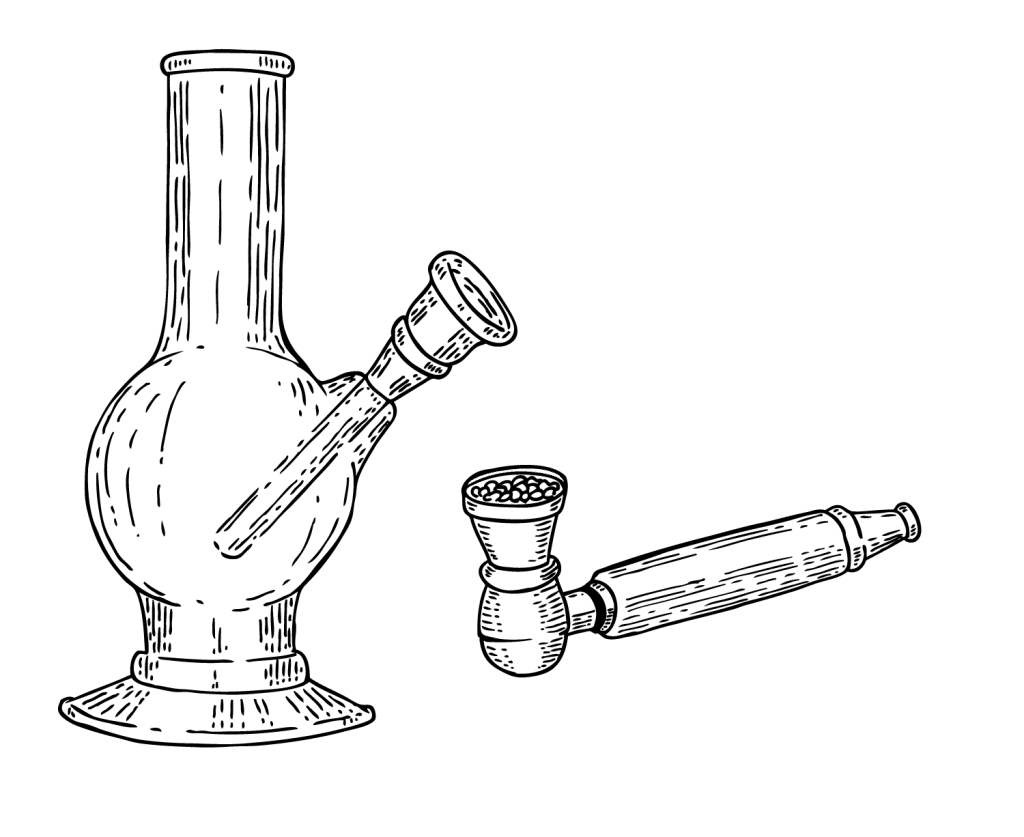
How Strong is Changa Compared To Other Psychedelics?
The active ingredient in changa — DMT — is potentially the strongest psychedelic substance on earth. Only substances like salvinorin A come anywhere close to matching it.
Changa vs. Ayahuasca
Changa ana ayahuasca have a lot of similarities. In fact, the original changa recipe calls for the ayahuasca vine as one of the chief ingredients as well as another common additive in the ayahuasca formula — called chacruna (Psychotria viridis).
The difference between changa and ayahuasca comes down to how they’re consumed. Changa is smoked, while ayahuasca is drunk as tea.
Changa also has a much shorter duration of effects — just 30 minutes on average — compared to 8 hours or more with ayahuasca.
There’s also a big difference in the traditional use of these substances. Ayahuasca has been used for centuries and has long-established ceremonial use. Shamans have developed a relationship with each ingredient in the ayahuasca mixture, and it takes a lifetime of training to be able to administer it.
Changa was only invented in the early 2000s by an Australian psychonaut, but the concept of smoking DMT-containing herbs isn’t new. Herbs like yopo have been used for a long time in South America, and some cultures have smoked the ayahuasca vine ceremonially as well.
Changa vs. Salvia
Some of the changa trip reports sound eerily similar to the salvia experience. There’s no official recipe for a herb mixture to classify as changa, so many of these blends likely contain at least some salvia in them.
The salvia experience is deeply strange — injecting users into a world that blends reality with complete chaos — sometimes scary chaos, sometimes not. Uncontrollable laughter is much more common in blends containing salvia than blends using ayahuasca vine or Syrian rue.
Changa and salvia are both used by smoking it. Both have a combination of extremely powerful psychedelic experience and short duration. Neither salvia nor changa last longer than 45 minutes. More commonly, the experience is over within about 20 minutes.
Changa vs. 5-MeO-DMT
5-MeO-DMT comes in two main forms — raw bufo toad venom and synthetic 5-MeO-DMT. Both are exceptionally strong — reliably providing deep spiritual experiences to those who use them.
Changa is comparable to 5-MeO-DMT in higher doses and leverages the exact same mechanism of action to get you there. The main difference between the two is celerity.
Celerity is a term that refers to the speed at which a substance brings you into the psychedelic realm, as well as the duration of effects.
Substances with a high celerity come on quickly but don’t last very long. Both changa and 5-MeO-DMT have a high celerity — but 5-MeO is higher.
Within about 5 seconds of smoking or vaping, just one toke of 5-MeO injects you into the third tier of the DMT experience — the alien realm.
Changa is quick too, but you’ll need to smoke more than one puff to get there, and it can take several puffs and a couple of minutes before you reach comparable levels as 5-MeO.
Is Changa Safe?
The original changa recipe used the ayahuasca vine and some synthetic DMT. Neither of these ingredients is harmful or poses many risks to the user. In fact, most of the indole-alkaloid-based psychedelics (such as magic mushrooms, LSD, DMT, and mescaline) have very little physical impact at all. These substances affect the mind, which can lead to certain side effects like anxiety or high blood pressure, but rarely trigger these effects on their own.
Because of how vague the ingredients list is for changa, there’s an added level of risk when using this substance. There is a lot of chemically enriched changa on the market today that’s been sprayed with harmful or potentially addictive substances to boost the psychoactive effect. Some manufacturers add synthetic cannabinoids, opiates, synthetic cathinones (AKA bath salts), PCP, damiana, Brugmansia, or other potentially harmful or addictive substances.
Additionally, the dose can vary substantially from one sample to the next. Some changa samples can be more than 100 times stronger than others, depending on what ingredients are used and in what ratio.
There’s, unfortunately, no good way to test the contents of changa to make sure it’s safe to use. You’d need to have access to precision lab equipment to know for sure.
Because of this problem, you should only use changa if it comes from a truly trustworthy source, or you’ve made it yourself, so you know exactly what’s in it and what isn’t in it.
Changa is a powerfully psychoactive substance and should be treated with respect. Don’t go into it with the intention of “getting messed up.” Using substances like this irresponsibly can lead to serious side effects. Ontological shock, for example, has physiological side effects that can remain for months or years if the experience isn’t integrated properly.
Changa Drug Interactions
You should never mix any prescription or over-the-counter medications with changa. Many different herbs can be added to the changa mix, most of which have overt pharmacological effects. This significantly increases the chances of a negative interaction with medications of all kinds.
The harmala alkaloids in plants like ayahuasca vine and Syrian rue are very likely to interact negatively with antipsychotic medications, heart medications, and antidepressants.
It’s wise to avoid mixing any substances with changa — even weed should only be used cautiously because of the shared psychoactive effects.
Never use changa if you have an underlying heart condition, high blood pressure, depression, severe anxiety, psychosis, or other mental illness. While there is something to be said for the impact of psychedelics like changa for mental health, there are other, better substances for this that have a proven track record for safety.
You should also seek out professional help from a registered psychedelic-assisted psychotherapist if your goal is to address a specific medical concern with psychedelics.
Changa Side Effects
The side effects of changa depend on the ingredients used for that particular blend. With that said, here are some of the most commonly reported side effects when using changa. Note that these are side effects of true changa, not side effects of changa that’s been “chemically enriched” — which is an entirely different beast altogether.
Side effects of changa include:
- Nausea & vomiting
- Dry mouth & throat
- Coughing or chest congestion
- Dizziness
- Tingling sensation in the hands & feet
- Headache
Is Changa Addictive?
Changa is not addictive in its own right.
However, some black market formulations use potentially addictive substances — like benzodiazepines or opiates. This is one of the reasons why you should only ever use changa that comes from a reputable source.
Psychedelics, in general, are rarely addictive. There are a few reasons for this:
- The body builds tolerance to psychedelics quickly — you’re very unlikely to feel anything if you use changa a second or third day in a row. You’ll need to wait at least a week for it to work again.
- The psychedelic experience is not something people want to do every day — while psychedelics can be fun, they can also be terrifying and uncomfortable. Most trips contain aspects of both. It’s not something people tend to do on a daily basis.
- Psychedelics can cause ego-dissolution — When the ego dissolves, even if just for a moment, it forces you to rethink your entire life. Most people come to the conclusion that they no longer need substances, which are used to treat addiction rather than lead to new addictions.
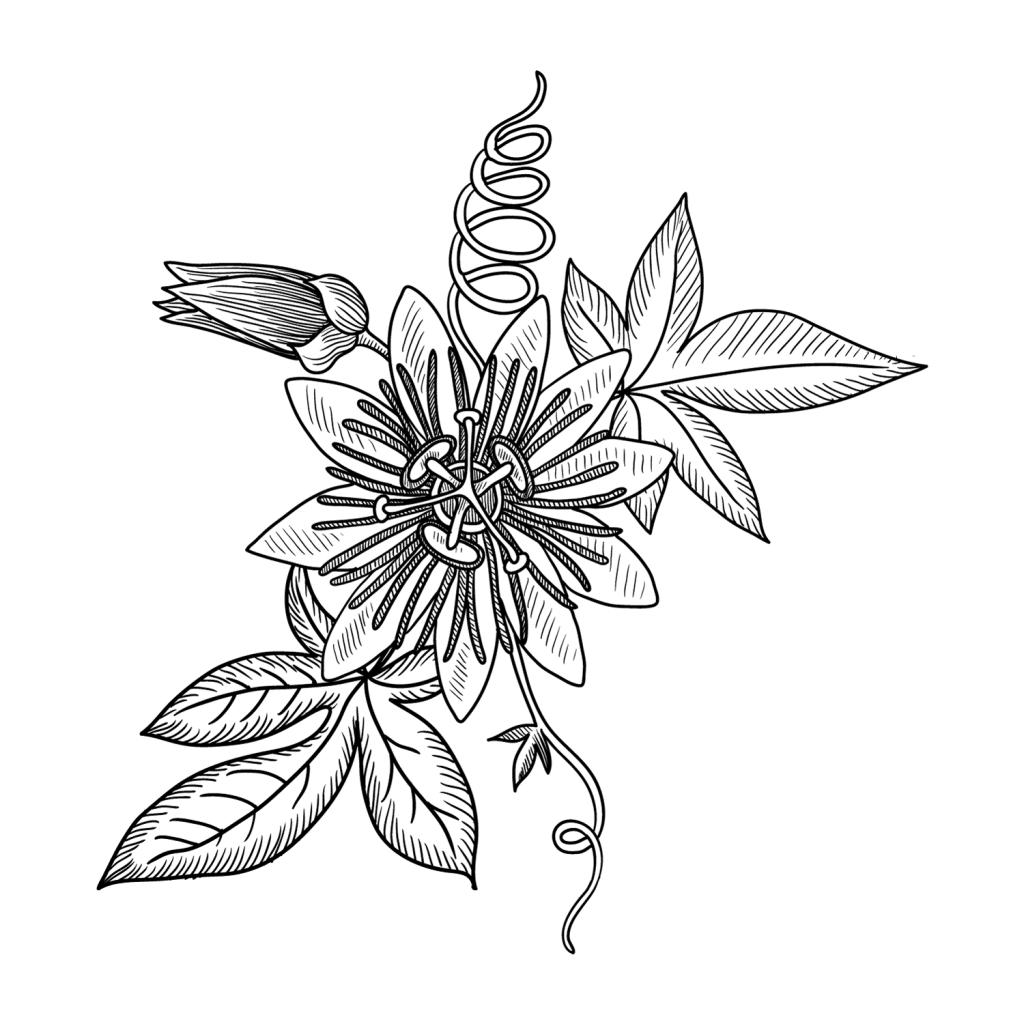
What’s In Changa? Changa Recipes
An Australian by the name of Julian Palmer began experimenting with smokable herbs in search of an ayahuasca alternative. He actually asked ayahuasca while sitting in the ceremony one day what he should call it — to which the response appears to be changa.
Julian Palmer has a recipe that’s considered the standard for creating changa, but there are many different modifications to this original recipe that work just as well. The beauty of this mixture is that you can pick and choose between many different ingredients depending on what’s available to you. The overall effects are going to be similar, but not the same depending on what ingredients you decide to go with.
Changa can be as simple as an MAO inhibitor and DMT source, or it can be more complex — with other herbs added to improve the flavor, provide relief from common side effects, boost a particular psychotropic effect of the mixture, or smooth out the smoke.
Here are some options to consider if you’re planning to make your own changa.
MAO Inhibitors
- Ayahuasca vine (Banisteriopsis caapi)
- Syrian rue (Peganum harmala)
- Passionflower (Passiflora incarnata)
- Synthetic harmala alkaloids (harmaline, tetrahydroharmine, & harmine)
DMT Sources
- Acacia Tree (Acacia obtusifolia, A. confusa or A. acuminata)
- Chaliponga (Diplopterys cabrerana)
- Chacruna (Psychotria viridis)
- Reed canary grass (Phalaris brachystachys)
- Yopo (Anadenanthera peregrina)
- Cebil (Anadenanthera colubrine)
- Synthetic DMT
- Mimosa (Mimosa hostilis)
Flavor Enhancers
- Peppermint (Mentha piperita)
- Lavender (Lavandula angustifolia)
- Blue Lotus (Nymphaea caerulea)
- Chapantye (Justicia pectoralis)
Smoke Enhances (Makes it More Smooth)
- Mullein (Verbascum thapsus)
- Tobacco (Nicotiana tabacum)
- Raspberry leaf (Rubus idaeus)
- Coltsfoot (Tussilago farfara)
Herbs That Reduce Side Effects
- American skullcap (Scutellaria lateriflora)
- Wild lettuce (Lactuca virosa)
Psychoactive Additives
- Calea (Calea zacatechichi) — Promotes more vivid dreams
- Mugwort (Artemisia vulgaris) — Promotes more vivid dreams
- Indian Warrior (Pedicularis densiflora) — Psychoactive and sedating
- African Dreamroot (Synaptolepis kirkii) — Promotes more vivid dreams
- African Dreamroot (Silene capensis) — Promotes more vivid dreams
- Marijuana (Cannabis sativa) — Enhances the psychoactive effects
- Damiana (Turnera diffusa) — Enhances the flavor and provides a euphoric sensation
- Sun Opener (Heimia salicifolia) — Increases auditory hallucinations
- Salvia (Salvia divinorum) — Provides additional psychedelic effects
I’ve seen mentions of people mixing datura or Brugmansia in with their changa — but I highly recommend you never do this.
These plants are powerfully psychoactive, but not in a good way. They’re considered deliriant, which means they induce a temporary state of delirium. The experience is often described as terrifying and devilish. It isn’t a healing experience for anybody and can even lead to long-term physical or psychological harm. Some of the ingredients in these plants are lethal as well.
At the very least, I urge you to do more research on these plants before you consider them.
Julian Palmer’s Changa Recipe:
Julian Palmer is the “inventor” of changa as we know it today. Here’s his original recipe:
Herb Portion:
- Ayahuasca vine (Banisteriopsis caapi)— 30%
- Mullein (Verbascum thapsus) — 20%
- Passionflower (Passiflora incarnata) — 20%
- Peppermint (Mentha piperita) — 20%
- Calendula (Calendula officinalis) — 5%
- Blue lotus (Nymphaea caerulea) — 5%
DMT Portion:
Using synthetic DMT, add about 25% of the total weight of the herb mix above. So for 1 gram of herb mix, use about 250 mg of DMT.
Instructions
- Melt the DMT using a steam bath
- Add the DMT to some vodka
- Coat the herbs in the DMT-infused vodka and leave it out to dry
Dosage:
The suggested dose for this formula, as per Julian Palmer’s recipe, is vague. He suggests about 4 grams of changa prepared this way is enough for about 30 light doses, 20 “decent” doses, 10 strong doses, or 5 very strong doses.
In terms of weight, this works out to the following dosages:
- Light dose — 133 mg (~30 mg DMT)
- Moderate dose — 200 mg (~50 mg DMT)
- Strong dose — 400 mg (~100 mg DMT)
- Very strong dose — 800 mg (~200 mg DMT)
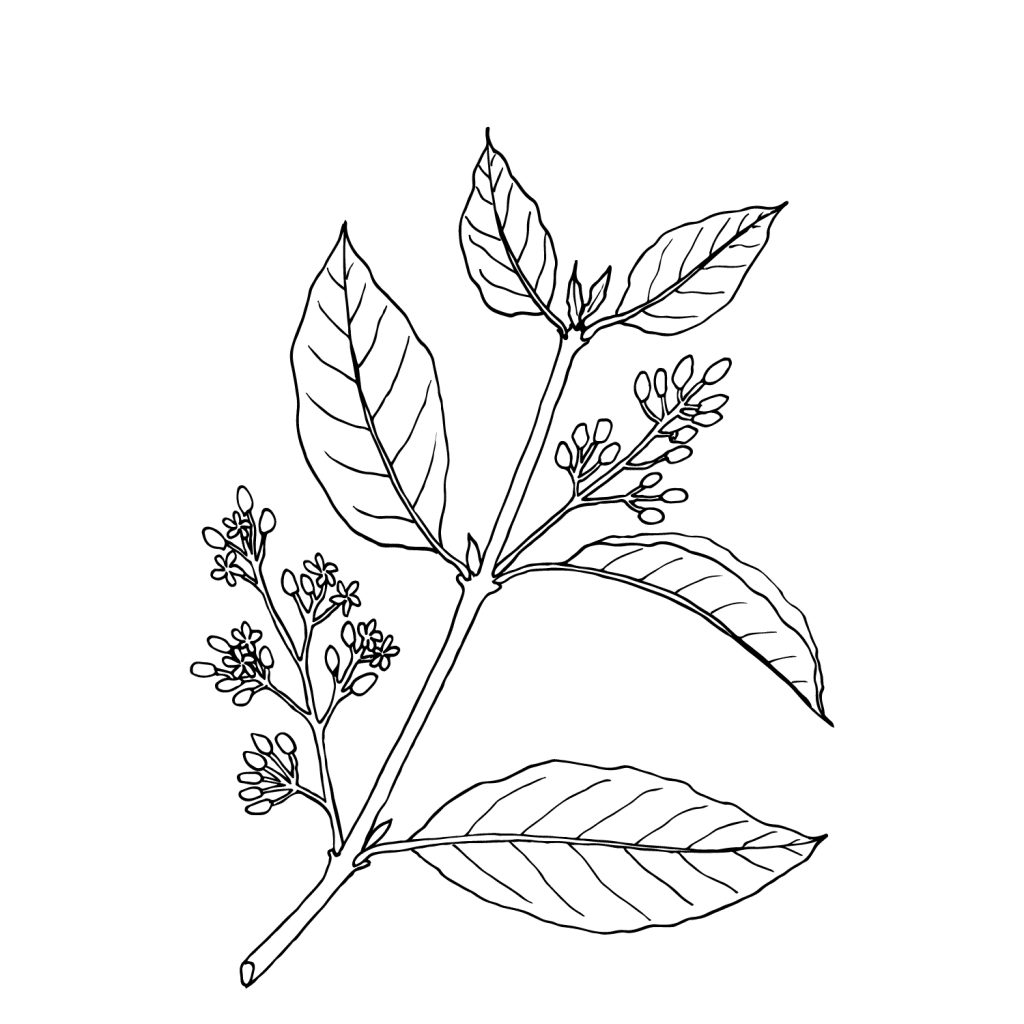
Is Changa Legal?
Changa is technically legal in the US, Canada, Australia, and most of Europe because most of the active ingredients are considered legal (some exceptions).
Most changa recipes include herbs like mimosa, peppermint, Syrian rue, or calendula — none of which are illegal. In some places, the ayahuasca vine is listed as a restricted substance, and any changa that contains synthetic DMT or MAO inhibitors are illegal.
The whole point of changa is to provide a source of bioavailable DMT using plants that grow nearby or are easily sourced online. This includes finding plant sources of DMT that are legal in places where other psychedelics are prohibited.
Julian Palmer lives in Australia, which is notoriously restrictive on psychedelic substances. He calls for the use of common tree species like acacia as a source of DMT, along with MAO inhibitors like passionflower or the ayahuasca vine (which is legal in raw form in Australia).
Frequently Asked Questions About Changa
1. Can I Use 5-MeO-DMT to Make Changa?
Technically you can, but this isn’t recommended. Not only is it not necessary to take harmala alkaloids with 5-MeO, it often leads to negative experiences.
It’s much more common to use N,N-DMT instead. While the effects are similar, they aren’t identical.
2. How Much Does Changa Cost?
The cost of changa varies a lot. It ranges from about $5 per 100 mg, up to $30 per 100 mg. One gram of changa usually goes for around $100.
The high cost primarily stems from the cost of pure DMT, which makes up between 25 and 50% of the changa mixture. DMT is present only in very small concentrations in plants, so extracting and isolating it requires very large quantities of raw plant material.
One gram of changa may feel expensive, but this will provide a lot of doses. The average dose of changa ranges from about 100 mg up to 800 mg for a very strong dose. Most people use around 200 mg of a 25% DMT mix.
Final Thoughts: The Future of Changa
Changa has been around for close to 20 years now under the name changa, but the concept of smoking the ingredients of ayahuasca isn’t a new idea.
Today, changa is becoming increasingly popular as an alternative to other smokable forms of DMT, as well as ayahuasca itself. The ingredients are relatively easy to source and are legal in many parts of the world.
Changa is a formidable psychedelic, capable of injecting users into entirely different dimensions. The trip is very short-lived, lasting around 45 minutes or less for most people. It’s also more gentle than 5-MeO-DMT and allows users to more slowly transition into the DMT realm.
The downside of changa is the diversity of potential ingredients. You never really know what’s in changa, and some black market producers are adding dangerous ingredients to “intensify” the trip. There have been reports of changa laced with opiates, synthetic cathinones, synthetic cannabinoids, benzodiazepines, or datura. You should never order changa from a source you don’t trust. The best option is to make the changa yourself using raw herbs and concentrated N,N-DMT.
Always make sure to test your DMT before you use it to make changa, and avoid changa altogether if you’re taking prescription medications or have underlying heart, liver, kidney, or psychiatric disorders.

